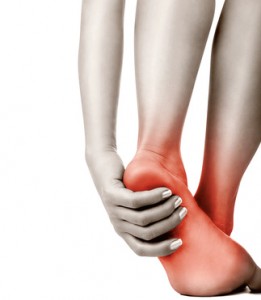If you find yourself experiencing sharp pains in your feet when you stand up, you may have plantar fasciitis. It typically comes and goes, especially while standing on your feet for long periods of time. This condition usually affects runners, because of the constant impacts to their feet. It can also affect those who don’t wear supportive shoes, or people that are overweight. If this pain sounds familiar to you, there are a couple of things you should know.
What is plantar fasciitis?
 Any time you hear “-itis” as a suffix, it means there is inflammation or a disease in a specific area. So plantar fasciitis is the inflammation of the plantar fascia. A thick, wide band of tissue, the plantar fascia runs along the bottom of your foot from the heel to your toes. This band is responsible for supporting the arch of your foot.
Any time you hear “-itis” as a suffix, it means there is inflammation or a disease in a specific area. So plantar fasciitis is the inflammation of the plantar fascia. A thick, wide band of tissue, the plantar fascia runs along the bottom of your foot from the heel to your toes. This band is responsible for supporting the arch of your foot.
If you wear shoes that don’t properly support the arches of your feet, are a runner, or are overweight, the plantar fascia can stretch out more than it is supposed to. When your feet make contact with the ground, this overstretched tissue is compressed, causing sharp pains to shoot up into the foot.
Unfortunately, plantar fascia isn’t something that is going to go away overnight. Plantar fasciitis actually has some traits of being a degenerative disease, and can take as long as 18 months to resolve. Early detection may reduce the amount of time needed to treat the disease, so it’s important to have your feet looked at immediately if you suspect you have plantar fasciitis.
How is it treated?
A doctor will do a physical examination, as plantar fasciitis can be typically be determined without an x-ray. However, your doctor may order an x-ray in order to rule out bone spurs, fractures, or other structural problems that could be causing the foot pain.
There are several options for resolving plantar fasciitis. If the treatment at the urgent care isn’t effective, you may be referred to a specialist. Treatment options include:
- Rest
- Stretches
- Icing the foot
- NSAIDS
- Corticosteroid shots
- Braces
- Physical therapy
- Shock wave therapy
In extreme cases, surgery may be required to repair the damage to the plantar fascia, but this is rare. You shouldn’t have to suffer through sharp foot pain every day. If you suspect you have plantar fasciitis, come down to the urgent care and let us take a look. We’ll do whatever we can to get you back on your feet.
